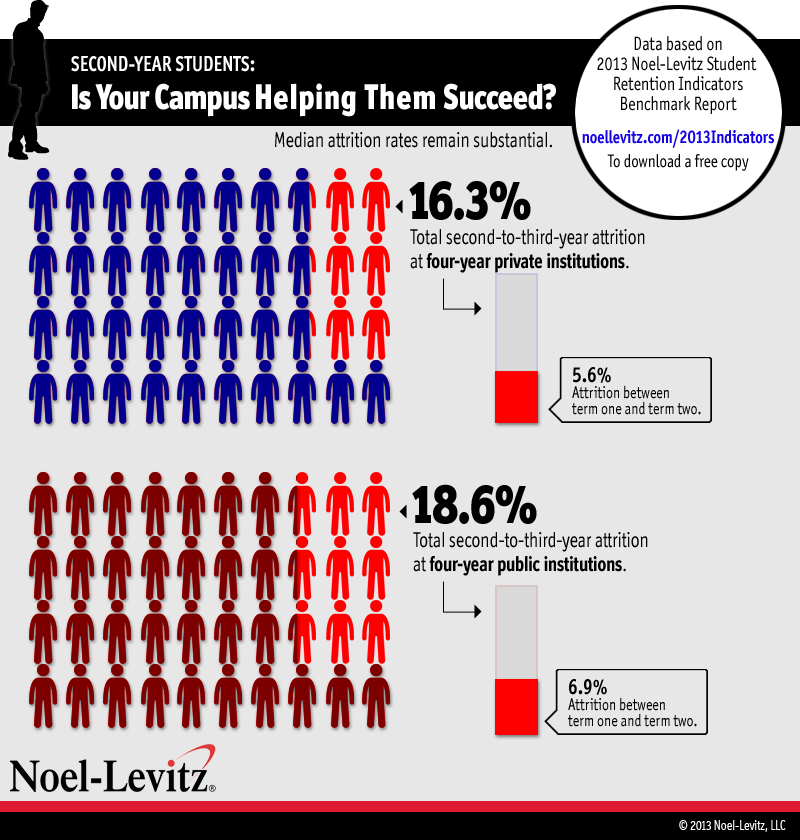enrollment
Raising the bar on college completion: New benchmarks provide standards for progress

The National Commission on Higher Education Attainment recently released an open letter to college and university leaders called, “College Completion Must Be Our Priority,” which extols the importance of focusing on college completion and student retention initiatives. Clearly, the momentum is building for higher education professionals to consider the total value that they offer to students and their families – one that includes the likelihood that students will graduate from the institution.
The above graphic shows benchmark data from Noel-Levitz’s newly-released 2013 Student Retention Indicators Benchmark Report for Four-Year and Two-Year Institutions. These data show a median attrition rate of nearly 20 percent from the second to third year among second-year undergraduates at private and public four-year institutions, highlighting an important and often-overlooked focus for college completion efforts.
While second-to-third-year median attrition remains lower than first-to-second-year median attrition, it represents a substantial piece of total attrition and thus merits its own focus on most campuses. Comparative data from our 2009 and 2011 retention indicators reports show that four-year public institutions have seen an upward trend in sophomore attrition and are retaining fewer of these students than four years ago.
More college student completion benchmarks from the report
- At four-year private institutions, first-year students completed 93 percent of the credit hours they attempted in fall 2011 (median rate) and their re-enrollment for term two was 92 percent at the median.
- At four-year public institutions, first-year students completed 87 percent of the credit hours they attempted in fall 2011 (median rate) and their re-enrollment for term two was 89 percent at the median.
- At two-year public institutions, first-year students completed 77 percent of the credit hours they attempted in fall 2011 (median rate) and their re-enrollment for term two was 81 percent at the median. For second-year students, median re-enrollment for term two was 85 percent, and median second-to-third-year retention was 53 percent. (Note that the latter rate is attributable no only to attrition, but also to students who completed their degrees in two years.)
Using this data to set campus goals and improve college completion rates
The new benchmark data offer a valuable resource for campuses to compare themselves against peer institutions and to set critical college completion subgoals. Institutions that use these metrics are also able to more accurately forecast student retention and college completion rates.
Further, campus leaders can use the report’s breakdowns by selectivity, along with its first- and third-quartile benchmarks, to establish the relative effectiveness of their retention programs and to set incremental institutional goals that will lead to higher completion. Used in this way, the data provide an actionable starting point for improvements, a method for in-depth analysis of retention program effectiveness, and assistance with identifying specific institutional troubles.
The full 2013 Student Retention Indicators Benchmark Report includes guidance from our consultants on how to use the new benchmarks and is scheduled to be released in February. Please sign up for new Noel-Levitz research to receive your free copy by e-mail.
For further reading:
2011 Mid-Year Student Retention Indicators Report
See parallel findings to the 2013 study in this report from two years ago.
Fall 2012 New Student Enrollment and Retention Outcomes at Four-Year and Two-Year Institutions
See retention goal-setting data on page 6.
2012 Report: The Attitudes and Needs of Freshmen at Mid-Year
Learn how students’ needs and interests change as they progress through college.
2011 National Pilot Study/Research Report: The Attitudes of Second-Year College Students
Examine the concerns of second-year undergraduates.
2012 National Student Satisfaction and Priorities Reports
Explore returning students’ satisfaction levels and their commitment to re-enrolling.